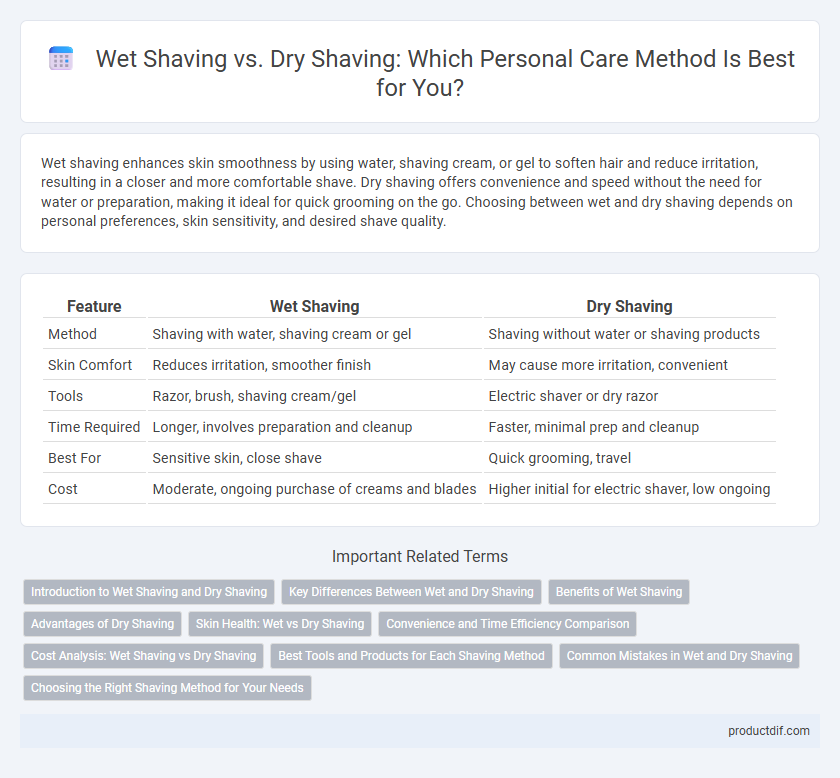Wet shaving enhances skin smoothness by using water, shaving cream, or gel to soften hair and reduce irritation, resulting in a closer and more comfortable shave. Dry shaving offers convenience and speed without the need for water or preparation, making it ideal for quick grooming on the go. Choosing between wet and dry shaving depends on personal preferences, skin sensitivity, and desired shave quality.
Table of Comparison
| Feature | Wet Shaving | Dry Shaving |
|---|---|---|
| Method | Shaving with water, shaving cream or gel | Shaving without water or shaving products |
| Skin Comfort | Reduces irritation, smoother finish | May cause more irritation, convenient |
| Tools | Razor, brush, shaving cream/gel | Electric shaver or dry razor |
| Time Required | Longer, involves preparation and cleanup | Faster, minimal prep and cleanup |
| Best For | Sensitive skin, close shave | Quick grooming, travel |
| Cost | Moderate, ongoing purchase of creams and blades | Higher initial for electric shaver, low ongoing |
Introduction to Wet Shaving and Dry Shaving
Wet shaving involves the use of water, shaving cream, or gel to soften hair and reduce skin irritation, providing a smoother and closer shave. Dry shaving utilizes electric razors without water or shaving products, offering convenience and speed with minimal preparation. Each method caters to different skin types and grooming preferences, with wet shaving often preferred for a traditional and thorough shave and dry shaving favored for quick touch-ups.
Key Differences Between Wet and Dry Shaving
Wet shaving utilizes water, shaving cream, or gel to soften hair and protect skin, resulting in a closer and smoother shave with reduced irritation. Dry shaving employs electric razors without water or shaving cream, offering faster, more convenient grooming ideal for sensitive skin prone to razor burn. Key differences include the method of hair softening, skin protection level, and the overall shaving experience suited to user preferences and skin types.
Benefits of Wet Shaving
Wet shaving provides a closer and smoother shave by softening facial hair with warm water, reducing irritation and razor burn. Using shaving cream or gel enhances skin hydration and lubrication, protecting against microscopic cuts and improving overall skin comfort. The combination of a sharp razor and proper wet shaving technique helps achieve precise results while maintaining healthy, exfoliated skin.
Advantages of Dry Shaving
Dry shaving offers the advantage of convenience, eliminating the need for water, shaving cream, or gels, making it ideal for quick grooming on the go. It reduces skin irritation and razor burn caused by moisture and friction, benefiting individuals with sensitive skin. Electric dry shavers provide a faster shaving experience with consistent results, promoting smoother skin without the mess of traditional wet shaving.
Skin Health: Wet vs Dry Shaving
Wet shaving benefits skin health by using water, shaving cream, or gel to soften hair and reduce friction, minimizing the risk of irritation and razor burn. Dry shaving, often performed with electric razors, can increase the likelihood of skin dryness and razor bumps due to the lack of lubrication and increased friction. Choosing wet shaving methods with quality moisturizing products supports better skin hydration and smoother post-shave skin.
Convenience and Time Efficiency Comparison
Wet shaving requires water, shaving cream, and usually a razor with multiple blades, making the process slightly longer but providing a smoother, closer shave and reducing skin irritation. Dry shaving, using electric razors, offers superior convenience and time efficiency by enabling quick grooming without the need for water or additional products, ideal for busy lifestyles or travel. Choosing between wet and dry shaving depends on balancing time constraints with preferences for comfort and skin care.
Cost Analysis: Wet Shaving vs Dry Shaving
Wet shaving typically involves higher upfront costs due to purchasing razors, shaving creams, and aftershaves, but offers better long-term savings with reusable blades and reduced skin irritation. Dry shaving requires electric shavers that often have a significant initial price and ongoing expenses for replacement foil and batteries or charging, making it costlier over time. Consumers prioritize wet shaving for its balance of affordability and effective grooming, while dry shaving suits those valuing convenience despite higher expenses.
Best Tools and Products for Each Shaving Method
Wet shaving requires high-quality razors such as safety razors or straight razors combined with shaving creams, gels, or soaps that provide lubrication and moisture for a smooth shave. Dry shaving works best with electric shavers designed with hypoallergenic blades and features like pivoting heads and pop-up trimmers for precision and skin comfort. Choosing the right pre- and post-shave products, such as moisturizing aftershaves or soothing balms, enhances skin protection for both wet and dry shaving routines.
Common Mistakes in Wet and Dry Shaving
Common mistakes in wet shaving include using dull blades and applying excessive pressure, which can lead to skin irritation and cuts. In dry shaving, many users neglect to clean the device regularly, causing clogged blades and ineffective shaving. Both methods benefit from proper technique and maintenance to reduce razor burn and achieve a smooth finish.
Choosing the Right Shaving Method for Your Needs
Wet shaving offers a closer, smoother finish by using water, shaving cream, and a razor, which helps reduce irritation and soften hair for sensitive skin. Dry shaving provides convenience and speed with electric shavers, making it ideal for quick grooming without the need for water or cream. Selecting the right method depends on skin type, time availability, and desired shaving comfort, ensuring optimal results for personal grooming needs.
Wet shaving vs Dry shaving Infographic

 productdif.com
productdif.com